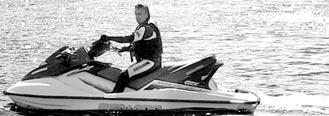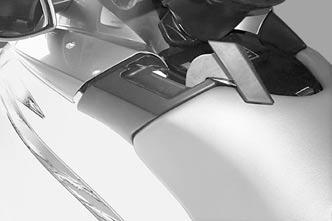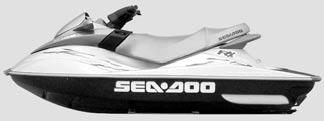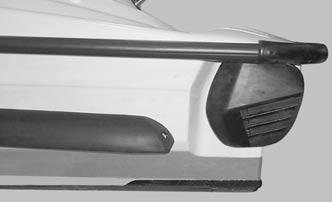
11 minute read
OPERATING INSTRUCTIONS
from 2003 Seadoo GTI GTI California GTI LE GTI LE RFI RX DI GTX DI Operator’s Guide Manual – PDF DOWNLOAD
WARNING
Always perform the PRE-OPERATION CHECKS before operating the watercraft. Become thoroughly familiar with all controls and the function of each. Should any control or instruction not be fully understood, refer to an authorized SEA-DOO dealer.
Principle of Operation
Propulsion
The engine is directly coupled to a drive shaft which, in turn, rotates an impeller. This impeller is accurately adjusted in a housing where the water is drawn up from underneath the watercraft. Then the water flows through the impeller to a venturi. The venturi accelerates the water and produces thrust to move the watercraft. Depressing the throttle lever increases engine speed and therefore watercraft speed.
TYPICAL
WARNING
Whenever the engine is to be started, the operator and passenger(s) should always be properly sitting on the watercraft and be wearing protective clothing including a Coast Guard approved PFD and a wet suit bottom.
WARNING
Keep away from intake grate while engine is on. Items such as long hair, loose clothing or personal flotation device straps can become entangled in moving parts resulting in severe injury or drowning.
The shift lever should be in the forward position in order for the watercraft to advance.
Neutral and Reverse
WARNING
Never use jet pump components as a supporting point to board the watercraft. Shift lever should only be used when the engine is idling and watercraft is completely stopped. Never rev the engine at high RPM in reverse. Do not use reverse to stop the watercraft. Only use reverse at slow speed and for the shortest time possible. Always ensure the path behind is clear of objects and persons including children playing in shallow water.
To find the neutral, set in reverse then push back until the watercraft stops moving backwards. The reverse gate will be in the middle position, directing half of the thrust toward the front of the watercraft to minimize watercraft movement. WARNING
When the watercraft is in neutral position, the drive shaft and impeller are still turning.

1. Shift lever in neutral position

1. Reverse gate in middle position
To obtain reverse, pull shift lever completely. The reverse gate will be in downward position, directing all the thrust toward the front of the watercraft.

1. Shift lever in reverse position 1. Reverse gate in downward position

NOTE: To obtain maximum efficiency and control from the reverse, increase engine speed to slightly above idle. Too much RPM will create water turbulence and reduce reverse efficiency. In reverse position, turn the handlebar in the same direction that you want to move the rear of the watercraft. For example, to steer the rear of the watercraft to the left side, turn the handlebar to the left side.

WARNING
Shift lever should only be used when the engine is idling and watercraft is completely stopped. Do not use reverse to stop the watercraft.
Variable Trim System (if so equipped)
The variable trim system (VTS) changes the angle of the jet pump nozzle to provide the operator with a fast, effective system to compensate for load, thrust, riding position and water conditions. Correctly adjusted, it can improve handling, reduce porpoising, and position the watercraft at its best riding angle to attain maximum performance. When first using the watercraft, the operator should become familiar with the use of the variable trim system (VTS) at varying speeds and water conditions. A mid-range trim is generally used when cruising. Experience alone will dictate the best trim for the conditions. During the watercraft break-in period, when lower speeds are recommended, it is an excellent opportunity to gain familiarity of trim adjustment and its effects. When the nozzle is positioned in an upward angle, the water thrust directs the bow of the watercraft upward. This position is used to optimize high speed.

TYPICAL 1. Push on arrow pointing upward on VTS button 2. Bow up 3. Nozzle up
NOTE: VTS position is indicated on a bar gauge in the information center. When the nozzle is directed downward, the bow is forced downward and enhances the watercraft turning capabilities. As with any watercraft, speed and operator body position and movement (body English), will determine the degree and sharpness of the watercraft turn. Porpoising can be reduced or eliminated if the nozzle is downward and speed is adjusted proportionately.

TYPICAL 1. Push on arrow pointing downward on VTS button 2. Bow down 3. Nozzle down
Steering
Turning the handlebar pivots the jet pump nozzle which controls the watercraft direction. Turning the handlebar to the right will turn the watercraft to the right and inversely. The throttle should be applied to turn the watercraft.

Unlike a car, a watercraft needs some throttle to turn. Practice in a safe area applying the throttle and turning away from an imaginary object. This is a good collision avoidance technique.
The watercraft behaves differently with a passenger and requires greater skill. The passenger should always grip the seat strap or grab handle. Reduce speed and avoid sharp turns. Avoid choppy water conditions when carrying a passenger.
WARNING
Throttle should be applied and handlebar turned to change the direction of the watercraft. Steering efficiency will differ depending on the number of passengers, load, water conditions and environmental factors such as the wind.
WARNING
On models without O.P.A.S. directional control is reduced when the throttle is released and lost when engine is off.
WARNING
On models with O.P.A.S. directional control is reduced when the throttle is released and/or when engine is off.
Models with Off-Power Assisted Steering System (O.P.A.S.)
Two side vanes on the rear sides of the hull, turn as the steering is turned to assist the watercraft turning. At first, carefully experiment turning with this system.

1. Side vanes turn following steering movement
When engine is running at approximately 75% or more RPM, the side vanes are automatically raised to upper position since they are not required at that vehicle speed range. Between 30% and 75% engine RPM, side vanes gradually raised from lower position to upper position.

1. Side vane in upper position
When throttle is released and engine RPM drops, the side vanes are automatically lowered thus assisting steering control.

1. Side vane in lower position
Boarding the Watercraft
General
As with any watercraft, boarding should be done carefully and engine should not be running. WARNING
Engine should be OFF when boarding the watercraft or when using boarding step (if so equipped). Keep limbs away from jet or intake grate. Stay on center of the step. Only one person at a time on the step. Never use the step for pulling, towing, diving or jumping, boarding a watercraft that is out of water or any other purpose other than a boarding step.
On some models, boarding is facilitated by using a step. WARNING
Inexperienced riders should practice how to get aboard (all methods explained here) close to shore first before venturing into deep water.
WARNING
Never use jet pump components as a supporting point to board the watercraft.
Boarding from a Dock or in Shallow Water
When boarding from a dock, slowly place one foot on the watercraft footboard nearest the dock and, at the same time, transfer the body weight to the other side in order to balance the watercraft while holding the handlebar. Then, bring the other foot over the seat and put it on the otherfootboard. Push the watercraft away from the dock.
Boarding in Deep Water
Operator Alone Swim to the rear of the watercraft.

Grip the grab handle and pull yourself upward until your knee can reach the boarding platform then grip the seat strap.
Bring your feet on the footboard while maintaining balance using the handlebar (except 3-up seat models).


A. 90 cm (3 ft)
In shallow water, board the watercraft either from the side or the rear.
F01L4KY
Sit astride the seat.
Operator with a Passenger The operator climbs on the watercraft the same way as explained previously. In choppy water, the passenger, while in the water, may hold the watercraft to help the operator in climbing aboard.
The passenger then climbs on the watercraft while the operator maintains balance by sitting as close as possible to the console.
Starting
Preparation
Before unloading the watercraft from the trailer, it can be started for about 10 seconds to verify proper operation. Attach the safety lanyard to your PFD and snap the cap to its post before starting the engine. NOTE: If you hear anything else than 2 short beeps from DESS system, it indicates a particular condition that should be corrected. Refer to the TROUBLESHOOTING section for the meaning of the coded signal.
WARNING
Components inside engine compartment may be hot. Do not touch electrical parts or jet pump area when engine is running.
WARNING
Before starting the engine, the operator and passengers should always be properly seated.
Position shift lever to neutral. Turn the fuel tank valve (if so equipped) to ON position. Firmly grip handlebar with your left hand and place both feet on the footboard. To start engine, depress and hold the engine start/stop button. Follow procedure below for cold or warm engine starting. If engine fails to start after 10 seconds, wait a few seconds then repeat procedure. CAUTION: Do not hold start/stop button more than 30 seconds to avoid starter overheating. A rest period should be observed between the cranking cycles to let starter cool down. Pay attention not to discharge battery. The engine should be started only after boarding, when there is at least 90 cm (3 ft) of water below the hull. Do not accelerate fast. Release engine start/stop button immediately after engine is started.
Carburetor-Equipped Models Cold Engine
The choke is provided to supply a richer fuel/air mixture when starting a cold engine. Fully pull the choke lever and hold while starting the engine.

TYPICAL 1. Fully pull
After engine is started, release choke lever. It may be necessary to reapply the choke and if necessary, slightly apply throttle to keep engine running.
Warm Engine
The choke does not need to be applied.
RFI and DI Models Cold and Warm Engine
Do not depress the throttle lever to start either a cold or warm engine.
All Models Riding
Slowly accelerate to reach deeper water. Do not apply full throttle until the engine is warm.

CAUTION: Avoid watercraft operation in weeded areas. If unavoidable, vary watercraft speed.
Rough Water or Poor Visibility Operation
Avoid operation in these conditions. If you must do so, proceed with caution and prudence using minimum speed.
Crossing Waves
Reduce speed. Always be prepared to steer and balance as necessary. When crossing wakes, always keep a safe distance from watercraft ahead. WARNING
When crossing wakes, slow down. Operator and passenger(s) can brace themselves by posting. Do not jump waves or wakes.
The watercraft is slowed by water drag. The stopping distance will vary depending on the watercraft size, weight, speed, water surface condition, presence and direction of wind and current.
The operator should become familiarized with the stopping distance under different conditions. Release the throttle at a sufficient distance before the expected landing area. Reduce speed to idle. Shift to neutral, reverse or forward, as required.

WARNING
On models without O.P.A.S. directional control is reduced when the throttle is released and lost when engine is off.
WARNING
On models with O.P.A.S. directional control is reduced when the throttle is released and/or when engine is off. CAUTION: It is not recommended to run the watercraft to the beach. Come slowly to the beach and shut off the using the safety lanyard when water depth is 90 cm (3 ft) under the hull, then pull the watercraft to the beach.
Shutting Off the Engine
To keep watercraft directional control, the engine should be running until the watercraft is at idle. To shut off the engine, completely release throttle lever and press the engine start/stop button. Remove safety lanyard from watercraft. WARNING
Should the engine be shut off, watercraft directional control is lost (reduced on models with O.P.A.S.). Never leave the safety lanyard on its post when watercraft is not in operation in order to prevent accidental engine starting or to avoid unauthorized use by children or others or theft.







